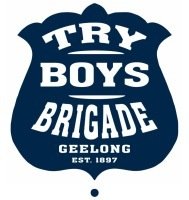The Founder.
A movement which began in Geelong a century ago and continues to thrive today has been a cradle of influence for thousands of young people in the region. The Geelong Try Boys' Brigade centenary gives reason to celebrate the valuable youth welfare work which it has accomplished in the Geelong region during this period.
It was established at a time when horse-drawn vehicles clattered along streets lit by gas and continued without faltering to the electronic age of today. It remained strong through a century which saw two world wars and enormous political, social and economic upheaval.
Few people are aware of the extent of the brigade's work as it has never been widely publicised. This is perhaps due to the nature of the man who founded and those who later nurtured it through its century. Their philosophy has been to get on with the job without fuss or fanfare.
Much of the Brigade's history is to be found in ten leather covered 'minute' books which detail every committee meeting since 1897 and with some sections of the early volumes hand-written in fine, ink copperplate script. A century of annual reports have also been diligently stored in a large black tin box. All this has been kept for posterity in a safe at the Brigade headquarters. Further research brought forth scant information as little has been written over the years to document the efforts of the industrious committees which have controlled the club.
The brigade was begun by a man who had emigrated to Australia thirty-two years earlier. In 1865 the young Charles Shannon sailed from Scotland with his family leaving behind their home in Greenock on the Firth of Clyde not far from Glasgow.
After a difficult and dreary three month sea voyage the family soon settled into life in Geelong and Charles joined some cousins in the wool trade. They later merged with Strachan and Co. and he became a partner in Strachan, Murray and Shannon. There were also other business ventures including partnerships in the Clyde Fellmongery and Godfrey Hirst's mill.
An energetic and enterprising man, Shannon was involved in community life in Geelong and held office in civic and sporting organisations. After five years on the Geelong Town Council he became mayor of Newtown and Chilwell and was the first captain of the Barwon Rowing Club.
In 1875 he married Emily Agnes Strachan and they had eight children. He was chairman of the first council of management at The Geelong College where four of his sons were students. One of the school houses is called Shannon in his memory. The family lived at St. Helen's for a few years before Shannon commissioned a large two-storey home in Prospect Road, Newtown, which today is a reception centre called Kirrewur Court.
When he became president of the Chamber of Commerce in 1890 Shannon headed a powerful group of men - most of whom were connected with imports and exports. These men were aware of the growing chasm between rich and poor which had worsened in the 1880's when economic conditions eventually led to depression.
The disastrous land boom bust resulted in widespread poverty and unemployment - most people found it difficult to pay their way. Children suffered badly with hungry, ragged, bare-footed boys roaming the streets. Some made a few pennies selling newspapers; many hung around pastry cooks' shops in the hope of scoring leftovers or stale offerings.
Homeless newsboys were a part of life in many cities during this period. They were a lost generation of forgotten street urchins victimised by exploitation, corruption, poverty and disease. Many were arrested for drunkenness and petty crimes.
Newsboys in Geelong were no different. They sold the Geelong Advertiser for one penny. It usually consisted of six pages of 48 columns of tightly-packed text. A typical front page included stories about the perils of drinking on a Sunday afternoon, a diphtheria outbreak which taxed accommodation at the hospital, advertisements regaling the benefits of Markell's Pills for disordered liver, Cobb and Co. wagonettes and buggies for hire and a valuable discovery for the hair called Mexican Hair Renewer.
Geelong was a bustling sea port with Port Phillip Bay steamers docking daily at the former Moorabool St. wharf between Cunningham and Yarra Sts. piers. On land it was also busy with Cobb and Co. coaches running between Geelong and Ballarat taking nine hours to do the trip. It was a time of horsedrawn vehicles, saddlers and blacksmiths - and streets dotted with wayward children.
An editorial in the July 28, 1897, edition of the Geelong Advertiser revealed that more than 80,000 school age children were absent from the public schools of the colony.
Explore the distinct Chapters in the history of The Geelong Try Boys' Brigade
